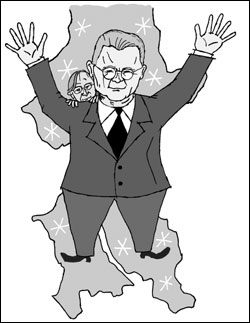THE SAME WEEK that many voters ignored last month’s primary election, a court ruling quietly threw onto the November ballot a local initiative more important than any particular electoral race. Ignore it at your peril.
Two years ago, a former aide to Seattle City Council member Charlie Chong ran for City Council against Richard Conlin. Jay Sauceda had all the right tools. In addition to his work for Chong, he had originated the highly valuable “911” guides to local government. But Sauceda ran not to win but to draw attention to a ballot initiative he was floating, to convert the Seattle City Council from nine members elected citywide to a mixed system of three elected at large and six elected by geographical district. By selecting six members by neighborhood, Sauceda argued, council members would be far more responsive to their constituents’ needs and desiresbecause they would actually have an identifiable constituency. Moreover, challengers would have a better chance against incumbents. Elections would require less money, and candidates could campaign by actually doorbelling a neighborhoodsomething that’s humanly impossible to do citywide.
All in all, it was a great idea for a more accountable council. And Sauceda’s timing was awful. The economy was good, the neighborhood revolt that spawned Chong was dead, and the prevailing attitude seemed to be not to fix what wasn’t broke. Then 9/11 struck, and nobody was thinking much about City Council anyway.
In politics, timing is everything. Fast forward two years, and now, rather than a good idea at a bad time, Sauceda’s baby has become a bad idea at the perfect time.
Suddenly, with a lousy economy and a string of negative stories, voters are strongly anti-incumbent. Because the City Council didn’t think this initiative would be on the November ballot, it didn’t bother to place a better version on the ballot opposite it. And so an initiative that would put every incumbent on the council up for re-election (or district him or her out of office) in two years will be voted up or down in less than a month.
IT MIGHT WELL pass. And it shouldn’t. What we will vote on next month is not the same proposal Sauceda was hawking in 2001. The difference is criticaland how that difference came to pass shows exactly why the new version is more dangerous than welcome.
The version we’ll vote on Nov. 4 has no at-large seats. It would convert the entire City Council to nine districted seats.
How did this district initiative go from a 6-3 mix to a 9-0 system? Because that was the condition for Mayor Greg Nickels’ support, and initiative supporters, lacking patrons in Seattle’s political establishment, sold their souls to the mayoral devil.
Nickels does not want a 9-0 district system because he thinks it will serve Seattleites better. He wants it because it will serve Greg Nickels better. He’ll have a trump card for his thus-far-contentious relations with the council. He’ll be able to claim that only he represents the entire cityable to say that any council member opposing his (or Paul Allen’s) desires speaks only for the parochial interests of his or her district.
The presence of at-large members in a council system is a critical check. It prevents the rise of ward politics. It makes it harder for lobbyists or business interests to pick off council members district by district. It makes it harder for power-hungry mayors to dominate city politics.
ONE OF THE BIGGEST benefits of a district system is it would overturn the arcane committee structure of the City Council. Currently, each member chairs a committee (parks, utilities, police, etc.). Other council members defer to their colleague in matters involving that committee. The result: staff (or the Police Guild) leads the council member around by the nose, and if the council member doesn’t care about constituent problems, you’re out of luck.
But what happens to a district system without any at-large members? Rather than, say, Jim Compton merely not returning your calls about police abuse, Jim Compton (or whoever) could be a roadblock to any matter you have with the city. The Seattle School Board and the current voter revolt against its dreadfully mismanaged education system are a prime example of how a theoretically responsive setup can become, in real life, a collection of unaccountable hacks.
That’s the system Nickels got put on the ballot. It’s a different kind of politics than Seattle is used to, but that doesn’t make it any less dangerous. It’s unfortunate, but the removal of that critical check and balance has turned what was once a good idea into a very, very bad one.







